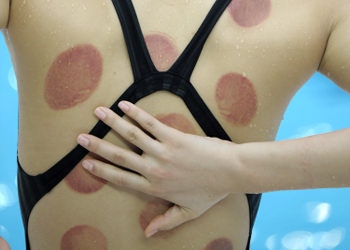Suite 3, Ground Floor, The Gateway,
312 St Kilda Road, Southbank, VIC, 3006
Cool Cupping Quips

COOL CUPPING QUIPS
RIDDLE ME THIS:
The swimmer pictured below…
- a) Had a fight with an octopus
- b) Went too hard on her spiky ball routine
- c) Had a cupping treatment recently
 Chinese swimmer Wang Qun is seen with marks after cupping treatment during a training session at the National Aquatics Center a few days before the start of the Beijing 2008 Olympic Games. (MICHAEL KAPPELER/AFP/Getty Images)
Chinese swimmer Wang Qun is seen with marks after cupping treatment during a training session at the National Aquatics Center a few days before the start of the Beijing 2008 Olympic Games. (MICHAEL KAPPELER/AFP/Getty Images)
Without having confirmed with Wang Qun (the swimmer pictured above), I can only assume the answer is c)! BUT, did you know that you don’t have to be bruised by cupping for it to make a lasting change! Cupping is an effective method of treatment used by many Myotherapists to elicit change throughout the myofascial system, and it can be done without leaving any marking!!
So, what is Myofascial Cupping?
Myofascial Cupping, also known as Myofascial Decompression, is the process of using a jar-like cup suctioned to the skin to allow the stretch and hydration of fascia, the mobilisations of blood and other fluids (such as the ever important lymph fluid) around the body, and the decompression of Myofascial trigger points (a.k.a. knots!). The system most affected by cupping is your fascial system – that strong layer of cling-wrap type substance the covers every inch of your muscles under the skin.
Before you read any further, click here for more info on fascia!
Common Misconceptions:
Cupping vs. Cupping!
As Cupping has increased in popularity, there is often an assumption that all forms of cupping are the same and yield the same results. Myofascial Cupping (or Myofascial Decompression) is different from the style of cupping used in the Traditional Chinese Medicine (TCM) discipline.
TCM cupping follows the traditional principal of meridian lines. The cups are placed along meridian lines to elicit change within the body as dictated by which particular line the cups are placed, as opposed to Myofascial Cupping in which cups are used along areas of physical myofascial tension. Two completely different methods using similar equipment can elicit such different results.
Bruising/Skin Marking
Each practitioner differs in their personal style of cupping, however cupping does not have to mark the skin to make a change. The (well-researched) curriculum that I was taught at RMIT University avoided marking the skin at all as discoloration of the skin during cupping may be indicative of damage to underlying tissue. With this teaching in mind, I avoid allowing cups to leave prolonged discolouration of the skin – a gentle reddening of the skin may occur but will dissipate quickly much like that of any marking during hands-on soft tissue work.
Detoxifying
While closely aligned with a method of detoxifying one’s body, this is not the end-focus of Myofascial Cupping. As mentioned earlier,
myofascial decompressions aims to lift, flood, and release tension of your myofascial system by allowing lymph flow, hydration, and blood flow of dehydrated compressed tissue.
Types of Myofascial Cupping
Dynamic Cupping:
This style of cupping is how it sounds – constantly moving! The cup or cups do not remain stationary for any prolonged period of time. In order for cups to be moved comfortably across the body, a small amount of lubricant such as lotion, oil, or cream is applied. Cups can then be moved along the lines of muscle and fascial fibres. The effect is much like “reverse massage” in that the skin, fascia, and muscles are not compressed but rather they are pulled away from each other promoting increased blood flow bringing oxygen and other nutrients to the tissue.
Static Cupping:
Through the process of Dynamic Cupping, tighter or “stickier” regions become apparent as the cups become reluctant to glide smoothly over them. When this occurs, Static Cupping can be used to apply a prolonged direct decompression to the region. As with Dynamic Cupping, this is in effect a reverse massage for instead of compressing tissue (that feeling when your practitioner stops and holds a point of pain), it is lifted and allows for flooding of nutrients.
But, when do I get Myofascial Cupping?
Cupping is a great treatment modality for a variety of musculoskeletal and myofascial dysfunctions.
- Muscular tension
- Fascial tension
- Delayed onset muscle soreness (DOMS)
- Stubborn oedema
- Restricted range of motion
- And more!
Do you think cupping might be right for you? See a professional!
Book in for a consultation with one of our expert Myotherapists
03 9686 2373
http://bit.ly/bookPMed

